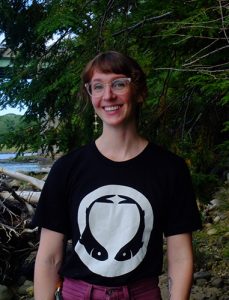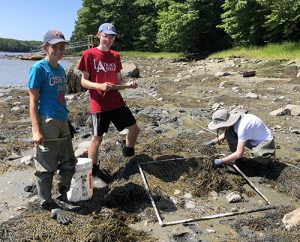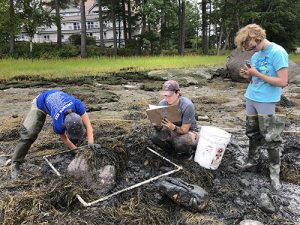Cultivating Coastal Stewardship in the Damariscotta Estuary
Researchers at UMaine’s Darling Marine Center develop a community research program in midcoast Maine

By Nate Poole
Survey the picturesque Damariscotta River and, among the many moorings and oyster farms, you might spot youthful figures hunched over the mudflat, waders on, clam rakes in hand. These are not shellfish harvesters, but local students gathering data to support the sustainable management of an ecosystem and industry.
This summer, Sarah Risley, a University of Maine graduate student based at the Darling Marine Center, is leading a team of university and high school students to study the shellfish populations of the upper Damariscotta estuary. They are also recording the local knowledge of harvesters who know the ecosystem the best. With funding from the Senator George J. Mitchell Center for Sustainability Solutions, the Broad Reach Fund, and local donors, the project’s novelty is two-fold: municipal shellfish managers do not have access to the information that these researchers are gathering, and the project’s approach, focused on community engagement, offers a different way to address that lack of data.
“We had a need for people in the field and then a local high school connection that was looking for field opportunities,” Risley said. “And so we kind of married those two asks and created a community science program with the idea that this is a way to engage local youth in marine careers and marine science in their backyard, while getting annual data sets that these students can then present … to the shellfish committee.”
Intertidal shellfish have, historically, been among Maine’s top three commercial marine fisheries, and its sustainability has been an incredibly important pursuit across Maine’s coastal regions. However, a variety of overlapping challenges trouble the industry, including bacterial pollution degrading water quality, predation by the invasive green crab, disappearing shoreline access for harvesters, climate change, and the limited capabilities of municipalities to track and address these issues.
Municipalities co-manage intertidal shellfish resources, including soft-shell clams, hard-shell clams (or quahogs), mussels, and oysters with the Maine Department of Marine Resources (DMR).
Matt Lutkus, who served as Damariscotta’s town manager until April 2022, said that the importance of the fishery to the town extends beyond harvesters, as its health is tied, directly and indirectly, to businesses across the region.
“Clammers and wormers depend on the mudflats here and in other areas in the region for their livelihood as do others involved in the processing of the harvest and on the retail portion of the business,” Lutkus said. “It is very important that our Shellfish Conservation Committee have the benefit [of] scientific data on [the] current status of the resource as well as information on historical trends based on the interviews with those with firsthand knowledge.”
Towns craft their own ordinances, within the guidance established by the state. The premise behind co-management is that local managers know how to best address the needs of their communities. While that premise holds water, managers often do not have the resources to collect data to support their decisions and verify their impacts.
In 2019, the Damariscotta-Newcastle Shellfish Committee decided to address this gap. The Town of Damariscotta applied for a grant on behalf of the committee from the Broad Reach Fund’s Shellfish Restoration and Resilience Fund. Harvesters, including some committee members, noticed a decline in softshell clams and an increase in oysters in the intertidal zone. They wanted to know what the cause of this shift might be and if there was anything that they could do about it. UMaine Darling Marine Center Director and Mitchell Center Faculty Fellow Heather Leslie is one of the six appointed members of the committee, representing the Town of Newcastle. Leslie, together with her students at the Darling Marine Center, helped the committee to develop an integrated research plan, drawing on both natural and social science methods, to address the questions that harvesters and others identified.
Connecting knowledge of people and place

At its outset, the study was focused on the ecology of the mudflats, contextualized with interviews recording harvesters’ knowledge of the estuary. However, the onset of the COVID-19 pandemic in 2020 brought field research to a halt, and Risley took the opportunity to fully embrace the social science dimensions of the project. Pushing research beyond single disciplines to integrate diverse knowledge is not a new experience for her; as a researcher in Leslie’s lab at the Darling Marine Center, her graduate education was nurtured in an environment where the mission is to integrate natural and social sciences to better connect people and the ocean.
The Mitchell Center is similarly dedicated to supporting faculty and student partnerships with local stakeholders to help find solutions to a wide range of urgent sustainability challenges and has supported a wide variety of research efforts involving coastal systems.
“The Mitchell Center grant was a really important catalysis for this project,” Leslie observed. “Not only has the award enabled us to stretch other funds farther, but the community of practice that the Mitchell Center has nurtured for more than a decade has been integral to how we developed the partnerships at the heart of this project.”
Risley and her colleagues dedicated 2020 to a participatory mapping study documenting local harvesters’ knowledge of how the ecosystem has changed. After participants mailed their survey results back to the UMaine team, the graduate students conducted interviews with each of them by phone. While the Darling Marine Center has been connected to the surrounding community since its founding in 1965 as the University’s marine laboratory, Risley’s goal was to make the project more directly responsive to stakeholder concerns and put herself and other researchers in a position to share results and solicit meaningful feedback. Through that process, she learned what species are most important to local harvesters, where they wanted data collected, and what their individual concerns were.
“It’s a heavy lift, which I think is why many scientists just kind of prefer to focus on their ecological system, but I think the effort is way worth the payoff,” she said. “The fact that you’re able to know that you’re doing science that’s actually relevant and answering people’s questions because you’re able to talk to them and ask, ‘Hey, what matters to you?’”
One thing that Risley and other researchers took away from harvester interviews is that things on the mudflat change all the time. That is why it is important that as the data collection in the field continues well into the future, so should the knowledge collection from local stakeholders. Risley said that a significant challenge with this kind of research is not only figuring out which questions are most important to local voices, but how to best communicate the results that address those questions. In either case, reducing engagement between researchers and harvesters would hinder the project’s success.
“If anything is changing, they’re going to see it first. They’re out there 365 days a year, sometimes twice a day … so they have their finger on the pulse,” she said. “We want to keep in touch with them because they are our experts and are guiding this whole process.”
Community science motivated by common goals
It might be hard to believe, but there is no quick or easy way of determining the health of a fishery. To meet their data needs, some shellfish committees require fishers to commit time to collecting ecological data on an annual basis, but Damariscotta and Newcastle do not. The Darling Marine Center’s field studies involve studying both young shellfish, or ‘recruits’ to the fishery, as well as the harvestable adults of the commercially valuable populations and their predators. Given the extent of intertidal flats managed by the towns, Risley knew early on that the labor demands would be significant.
“That’s just the nature of the beast. It’s costly, it’s time consuming, it’s labor intensive, and it’s hard to get up-to-date annual data, so we were trying to be creative with how to do that in a way that expands the capacity to the community at large,” she said.

Luckily, a path forward emerged when the Darling Marine Center and the local high school, Lincoln Academy, developed a partnership. One of the core activities of this collaboration is the community science shellfish project, where high school students contribute to the shellfish surveys and are mentored by undergraduate and graduate students based at the Darling Marine Center. Kelley Duffy, Director of Curriculum and Instruction at Lincoln Academy, said that prior to the partnership, many students were entirely unaware of the research opportunities in their backyard.
“Our connections [with Darling Marine Center] provide hands-on-learning opportunities that are accessible to all learners and have the potential to engage students in real world questions and problems that are meaningful to their lives – and their families lives right now. We are tremendously lucky to have this connection and to have such enthusiastic and patient partners [in Darling Marine Center],” Duffy said.
However, that is not to say that working with high school students does not present some significant logistical challenges. Before getting students into the field to collect data, Risley spent months meeting with Duffy and Lincoln Academy faculty to discuss their needs and potential educational activities. Risley then led development of the survey protocols and piloted them with students in several different ways over more than a year, before developing the model that ran this summer, in 2022. The collaboration also has helped to catalyze an Aquaculture and Aquaponics Club at the high school, as well as classroom-based collaborations. While there are plenty of logistical hurdles yet to iron out, Duffy believes that the partnership will only grow and become better integrated with curriculum. Particularly as pandemic restrictions fade, she hopes for more field trips and direct conversations with UMaine researchers.
Risley’s goal is to continue to engage high school students in community science, enabling them to participate in field ecology and social science studies, and to share the emerging results of their work with the shellfish committee and others in the community.
“I don’t know about your high school experience, but I certainly did not have access to that [type of experiential learning], and I think it would have really changed my career trajectory in a sense and would have really inspired me to go into the sciences earlier.”
Sarah Risley
Deepening partnerships across UMaine and local communities
In early August, Risley and her team shared their findings with community members during an evening meeting hosted by Leslie at the Darling Marine Center’s Walpole campus. The students were peppered with questions and pleasantly surprised by how many community members came out on a summer evening to learn more about the estuary and its shellfish. Already, some intriguing trends are emerging.
Among the three monitoring sites that Risley identified with harvester input, one has substantially more quahogs than the others. Oysters are distributed across all three sites; green crabs are also ubiquitous, but Risley cautions against reading too much into that pattern, given that green crab behavior and abundance varies widely from season to season. Data collection with students will continue into the fall, as UMaine Semester by the Sea students arrive to participate in undergraduate courses at the Darling Marine Center and Lincoln students return to the classroom.
With four years dedicated to an ambitious, multifaceted project like this, Risley offered up a simple bit of wisdom for those embarking on similar efforts: there is no fast track.
“It comes down to building relationships over time and figuring out where the pieces all fit and how we can meet needs and answer questions that are important locally,” she concludes.
